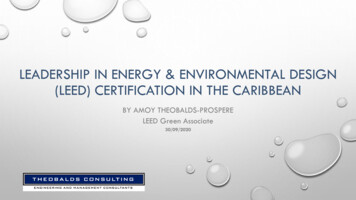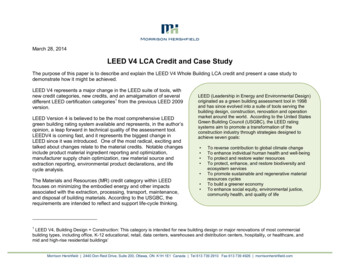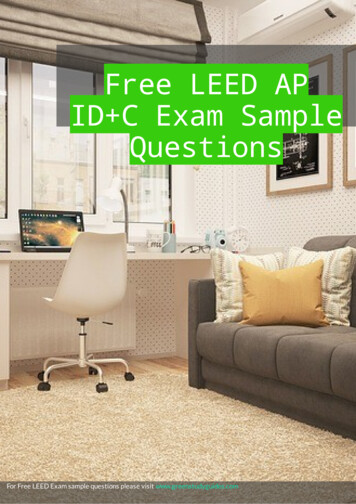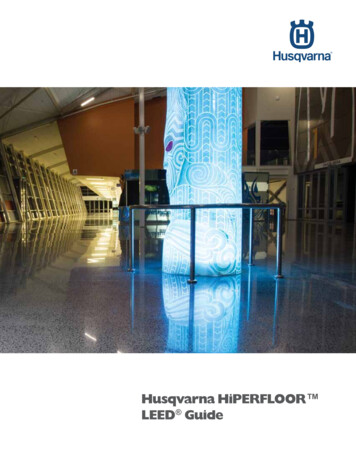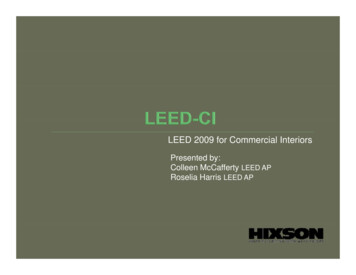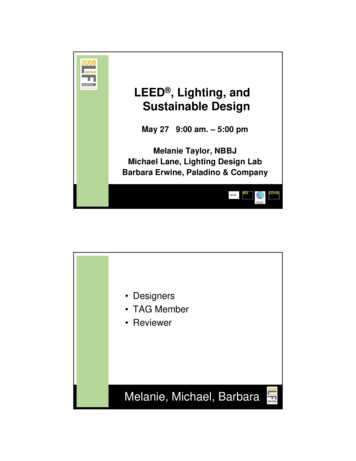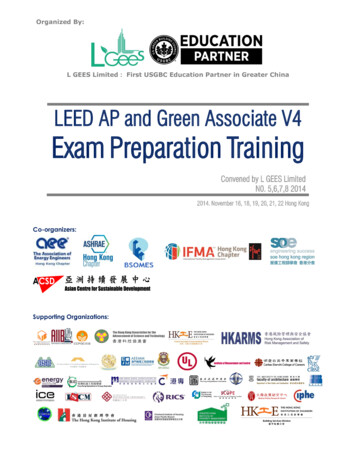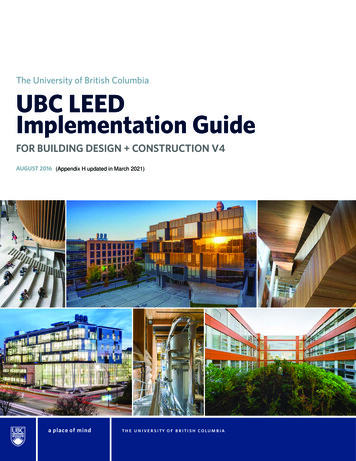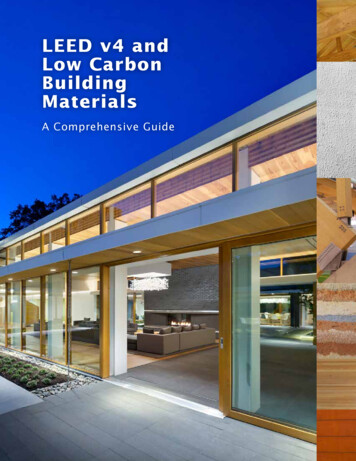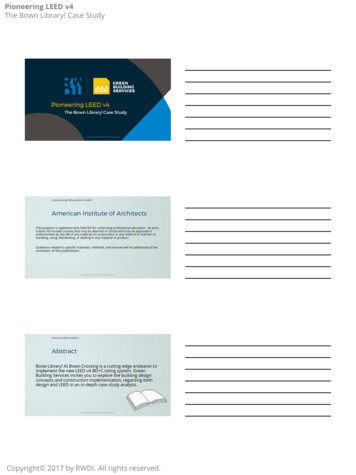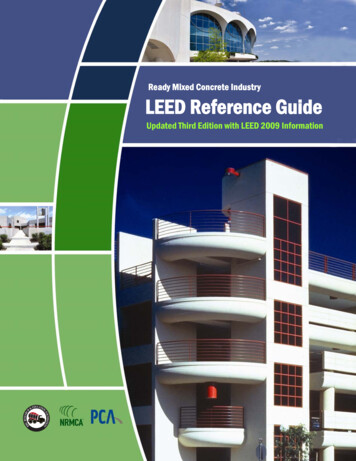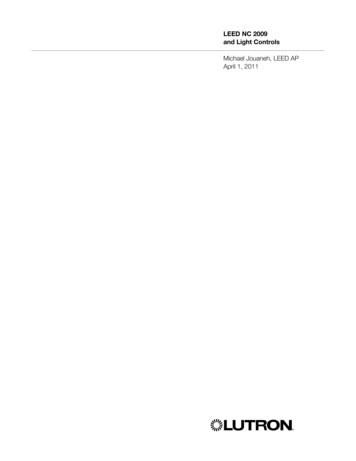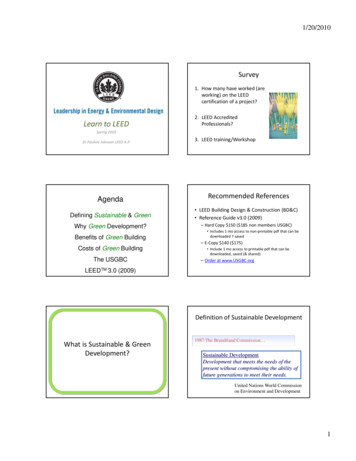
Transcription
1/20/2010SurveyLEED Sustainableg & ConstructionDesignLearn to LEED1. How many have worked (areworking) on the LEEDcertification of a project?2. LEED AccreditedProfessionals?Spring 2010Dr Pauline Johnson LEED A.P.Agenda3. LEED training/WorkshopRecommended ReferencesDefining Sustainable & Green LEED Building Design & Construction (BD&C) Reference Guide v3.0 (2009)Why Green Development?– Hard Copy 150 ( 185 non members USGBC)Benefits of Green Building IIncludesl d 1 mo access tot non‐printablei t bl pdfdf thatth t can bebdownloaded 7 saved– E‐Copy 140 ( 175)Costs of Green BuildingThe USGBC Include 1 mo access to printable pdf that can bedownloaded, saved (& shared)– Order at www.USGBC.orgLEEDTM 3.0 (2009)Definition of Sustainable DevelopmentWhat is Sustainable & GreenD lDevelopment?t?1987 The Brundtland Commission Sustainable DevelopmentDevelopment that meets the needs of thepresent without compromising the ability offuture generations to meet their needs.United Nations World Commissionon Environment and Development1
1/20/2010What is Green Building?Sustainable Building No net impact on the environmentGreen Building Incremental steps to solve known problems usingcurrent and emerging practices Today’s green building is typically not sustainable Greener than baselineWorld resources are finite .No longer OK for us to be sustainable “over there”“Dad! Mom!Please savesome for us!” . and we are depleting them ataccelerating & unsustainable ratesDepletionCurve for aNon‐RenewableResourceCumulative Cudiscovery vsextractionR. B. Gordon*, M. Bertram†‡ , and T. E. Graedel†§ Yale University,Edited by William C. Clark, Harvard University, Cambridge, MA, aPNASv.103, n.5, 31jan2006Cu Use bySector2
1/20/2010US Building PortfolioUS Residential and commercialbuildings 76 million residential 5 million commercial 20022002‐‐2010: 38 millionBuildings are a key contributor toresource use & environmental damageTHE BAD NEWS: The Negative Impacts of Buildings on EnvironmentTHE BAD NEWS: The Negative Impacts of Buildings on EnvironmentU.S DOE: buildings in the US:Buildings account for: 5 billion gal/d of potable waterused to flush toilets. A typical commercial constructionjob creates 2.5lb waste/ft2 floorspace Real estate developmentappropriates land from other usessuch as natural habitats andagriculture. 49% of sulfur dioxide emissions 25% of nitrous oxide emissions 10% of particulate emissions 35% of carbon dioxide emissionsBetween 2002 and 2010, 38 millionbuildings built worldwide.3
1/20/2010Sustainable DevelopmentThe Triple Bottom TestOVERVIEWRATIONALEUSGBCLEEDCONCLUSIONGreen Building is REALITYDesign andconstruction practicesthat significantlyreduce or eliminate thenegativei impactioffbuildings on theenvironment andoccupants in five broadareas:Test4
1/20/2010Life Cycle Assessment LCADecidingg on Greenness?What is Green?Is it Good Business?THE GOOD NEWS:Sustainability is catching on: Talk and Action Federally funded buildings Client/Owner Demand Engineers , Architects,Construction CompaniesTest5
1/20/2010THE GOOD NEWS: Public and Professional Awareness:THE GOOD NEWS: Availability of Building Materials in the MarketLEED Requirements for State BuildingsThe Benefits of Green BuildingPew Center 20086
1/20/2010Benefits Lower Operating Costs– Reduced energy use– Conserve waterimmediate& Consumer / Occupant Satisfaction– Improved comfort– Improved indoor air quality– Sense of “doing the right thing”measurable Good for the Environment– Reduced environmental impact: virgin resourcesdemands, wastes, greenhouse gas emissions,TestWhat does it l Construction CostsforbuildingsAverageLEED‐certifiedfor offices and schools, based on 40buildingsPLATINUMGOLDConventional Building Cost (100%)6.8%(2 buildings)2.2%(9 buildings)SILVER(8 buildings)What are the MajorGreen Building Standards?1.9%(21 buildings)CERTIFIEDAdditional CostTest.66%7
1/20/2010Global Green Building Programs: United States: United ce:Germany:Hong Kong:India:Italy:Malaysia:Netherlands:New Zealand:Philippines:Portugal:Singapore:South Africa:Spain:Switzerland:LEED/ Living Building Challenge/ Green Globes/ Build itGreen/ NAHB NGBSBREEAM 1990Nabers/ Green StarAQUALEED Canada / Green GlobesGBASPromisEHQEDGNB/ CEPHEUSHKBEAMGRIHA, LEED IndiaProtocollo Itaca/ Green Building Counsil ItaliaGBI MalaysiaBREEAM NetherlandsGreen Star NZBERDE/ Philippine Green Building Council PHILGBCLider AGreen MarkGreen Star SAVERDEMinergieWhat is LEED?US Green Building Council (USGBC)www.usgbc.orgUSGBC MissionThe Triple Bottom LineOrganizationsNOT individualsare USGBCmembersUA Membersince 20088
1/20/2010US Green Building Council (USGBC)ProfessionalOrganizationgMeasure of“Greenness”There is No S in LEEDLeadership in Energy & Environmental DesignLEEDLeedsGreen Building Rating SystemCity in Central UKA rating system for designing,constructing, operating and certifyinggreen development.Why Was LEEDTM Created? Providing a standardLEED Certification vs Accreditation Provide design guidelines & Promote wholewhole--building, integrated designprocessesCertified Prevent “greenwashing“greenwashing”” (false/exaggeratedBuildings getCERTIFIEDclaims)l i ) Transform the marketplace Stimulate green demand & competitionUSGBCLEED Raise consumer awareness Recognize leadersAccreditedPeople getACCREDITED Triple Bottom LineLine- positive results for: environment, occupant financial return9
1/20/2010Current Accreditation ProcessEducational RequirementsLEED Accreditation ProcessTier IExperience& examTier IITier IIILEED FellowExam 1: LEED Green AssociateExam 1: LEED Green AssociateExam 2: LEED AP BD&C Specialty10
1/20/2010Exam 2: LEED AP BD&C SpecialtyProfessionals AccreditedLEED NC/BD&CVersionBuilding Rating SystemNew Construction (NC) LEED NC v2.0LEED‐NC v2.1LEED‐NC v2.2LEED‐BD&C v3.0Published2001200220052009 Updates every 2‐3 years11
1/20/2010Four levels of LEED‐NC/BD&CCertification AchievementCertifiedSilverGoldLEED 2.226‐3233‐3839‐52Platinum53‐69LEED 3.0/200940‐4950‐5960‐7980‐100Also 10 bonus points available under v3.0: total potential 11012
1/20/2010LEED v2.2LEED v3.0LEED‐NCnew constructionM. Miller Gorrie Building,AuburnLEED GoldCHM Architects & B&GS&E CompleX Phase IIIUALEED Silver?Davis ArchitectsLEED LOCALLYLEED v3.0RatingSystemChangesLEED‐SLEED BD&Cschoolsbuilding design & construction,NC/S/CS are sub groupsLEED‐CScore & shellLEED‐CILEED ID&CCommercial interiorsinterior design and constructionLEED‐EBLEED O&Mexisting buildingsoperations & maintenanceLEED‐HUnchangedhomesBank of Tusc. PlazaTuscaloosaLEED SilverGiattina Architecture StudiosLEED‐NDUnchangedneighborhood developmentBD&C SubcategoriesNew Points SystemBonusLEEDTM 3.0 (2009)Building Certification & Rating SystemWhat LEED NC Measures Sustainable Sites Referred to as both LEED 3.0 & 2009 Water Efficiency Whole-building approach encourages andguides a collaborative, integrated designand construction process Optimizes environmental and economicfactors Energy & Atmosphere Innovation in Design Regional PrioritySee the Regional Priority Credits foryour state » Materials & Resources Indoor EnvironmentalQuality13
1/20/2010Prerequisites and credits in the LEED 2009New Construction Sustainable Sites (SS)Water Efficiency (WE)Energy and Atmosphere (EA)Materials and Resources (MR)Indoor Environmental Quality (IEQ)Innovation in Design (ID)Regional Priority (RP)10010bonusNew Reference GuidesUnder LEED 3.0Sustainable SitesCredits & PointsSection 1: Sustainable Sites (SS)14
1/20/2010Section 2: Water Efficiency (WE)Efficient Water UseCreditsEnergy & AtmosphereSection 3: Energy and Atmosphere (EA)15
1/20/2010CreditsSection 4: Materials and Resources (MR)Materials & ResourcesCreditsIEQSection 5: Indoor Environmental Quality (IEQ)16
1/20/2010IEQ CreditsSection 6: Innovation & Design Process (ID)ID CreditsID Considerations Exemplary or Innovative performanceabove LEED requirements (4 Points avail.)–Exemplary Performance of LEED Credit–Academic Educational Programg–Green Operations and Maintenance e.g. Green housekeeping practices Organic Landscaping /Integrated PestMgmt Additional Construction Waste Mgmt. LEED Accredited ProfessionalInnovation PointsINNOVATION POINTSSection 7: Regional Priority (RP)17
1/20/2010RP BackgroundRP Credits Regionally specific environmentalissues identified.Regional Priority Credits for your state by zip-code »http://www.usgbc.org/DisplayPage.aspx?CMSPageID 1984 6 location specific LEED creditsprioritized.Up to 4allowedDowntownTuscaloosa ALZip code 35401SSc4 (25%)SSc6WEc2 (20%) Four points allowed (one point percredit) from 6 available.EAc1 (75 rating/25percentile)EAc4 3%/25%IEQc2.3t1LEED Certification ProcessLEED Online Certification ProcessSubmit both together duringconstructionDesign & ConstructionApplication LEED OnlineORRegisterProject Submit afterdesign phaseDesignApplication Submit close to ,orpost constructioncompletionDecision Post final Construction Project Closed No appealConstructionApplication18
Slide 132t1Change title to:Getting Started: Toolstechnician, 8/8/2008
1/20/2010Example ofHow to satisfy a LEEDprereq/credit/ dExample 1: Sustainable SitesLEED ChecklistSS‐NC Credits8 Achievable Sustainable Site Points Identified14 Possible19
1/20/2010SS Prerequisite 1SS Prerequisite 1Construction Activity PollutionPreventionConstruction Activity Pollution Prevention3. Intent: Reduce pollution fromconstructionactivities by 1. Required forNC,, Schools &C&S1.2.3.4. Requirements:Create & implement Erosion & SedimentControl (ESC)plan2. ConstructionPhase Credita)b)SS Prerequisite 1Construction Activity PollutionPrevention5. Strategies & Implementation6. DocumentationCreate ESC plan during design a) Stabilizationa)b)Temp. & permanent seedingMulching Copy of project drawingsdocumenting ESC measuresDocument implementation––b) Structural Controla)b)c)d)Comply with EPA 2003 NPDESConstruction General PermitLocal Standard/code if more stringentSS Prerequisite 1Construction Activity Pollution Prevention Control Soil ErosionReduce waterway sedimentsReduce airborne dustSilt fencingEarth dikeSedimentation traps/basinsDust control measuresDate stamped photosInspection logs or reports Describe corrective actionstaken Submit onlineLEED ScorecardCost Impact - AddMinor Cost Impact - AddYesMaybeNoTotal Project ScoreSustainable SitesYPrereq 11Credit 1Erosion & Sedimentation ControlSite SelectionCredit 2Urban Redevelopment1Keyword descriptionSediment and Erosion Control PlanAvoid Sensitive SitesIncreased Site densityCredit 3Brownfield Redevelopment1Credit 4.1Alternative Transportation, Public Transportation AccessProximity to Public Transportation1Credit 4.2Alternative Transportation, Bicycle Storage & Changing RoomsBike Storage and Changing RoomsCredit 4.3Alternative Transportation, Alternative Fuel Refueling StationsCredit 4.4Alternative Transportation, Parking CapacityCredit 5.1Reduced Site Disturbance, Protect or Restore Open Space11111Credit 5.2Reduced Site Disturbance, Development Footprint1Credit 6.1Stormwater Management, Rate and Quantity1111Credit 6.2Stormwater Management, TreatmentCredit 7.1Landscape & Exterior Design to Reduce Heat Islands, Non-RoofCredit 7.2Landscape & Exterior Design to Reduce Heat Islands, RoofCredit 8Light Pollution Reduction8 Achievable Sustainable Site Points IdentifiedRemediate Contaminated SitesAlternate Fueling / StationsMeet/Not Exceed Zoning - Van Pool Park'g.Restored habitat for 50% of open spaceOpen space Building Footprint Predevelopement or 25% decreaseEliminate Contaminants - Onsite FiltrationHigh Albedo / Open Grid ParkingEnergy Star Compliant RoofIESNA CutoffsQuestions?14 Possible20
Benefits of Green Building Costs of Green Building The USGBC LEEDTM 3.0 (2009) Recommended References LEED Building Design & Construction (BD&C) Reference Guide v3.0 (2009) – Hard Copy 150 ( 185 non members USGBC) IldIncludes 1 mo access to non‐pritblintable pd
